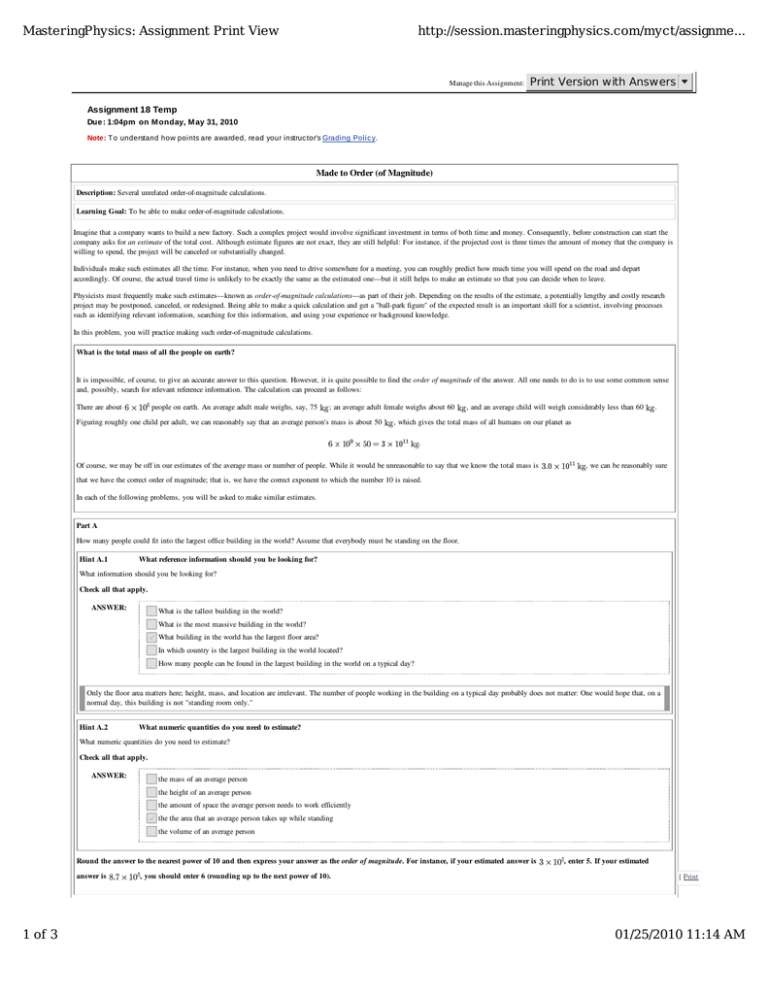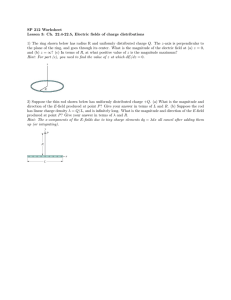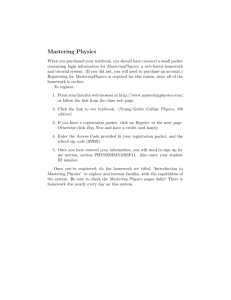MasteringPhysics: Assignment Print View http://session
advertisement

MasteringPhysics: Assignment Print View http://session.masteringphysics.com/myct/assignme... Manage this Assignment: Print Version with Answers Assignment 18 Temp Due : 1:04pm on M onday, M ay 31, 2010 Note: T o understand how points are awarded, read your instruc tor's Grading Polic y. Made to Order (of Magnitude) Description: Several unrelated order-of-magnitude calculations. Learning Goal: To be able to make order-of-magnitude calculations. Imagine that a company wants to build a new factory. Such a complex project would involve significant investment in terms of both time and money. Consequently, before construction can start the company asks for an estimate of the total cost. Although estimate figures are not exact, they are still helpful: For instance, if the projected cost is three times the amount of money that the company is willing to spend, the project will be canceled or substantially changed. Individuals make such estimates all the time. For instance, when you need to drive somewhere for a meeting, you can roughly predict how much time you will spend on the road and depart accordingly. Of course, the actual travel time is unlikely to be exactly the same as the estimated one—but it still helps to make an estimate so that you can decide when to leave. Physicists must frequently make such estimates—known as order-of-magnitude calculations—as part of their job. Depending on the results of the estimate, a potentially lengthy and costly research project may be postponed, canceled, or redesigned. Being able to make a quick calculation and get a "ball-park figure" of the expected result is an important skill for a scientist, involving processes such as identifying relevant information, searching for this information, and using your experience or background knowledge. In this problem, you will practice making such order-of-magnitude calculations. What is the total mass of all the people on earth? It is impossible, of course, to give an accurate answer to this question. However, it is quite possible to find the order of magnitude of the answer. All one needs to do is to use some common sense and, possibly, search for relevant reference information. The calculation can proceed as follows: There are about people on earth. An average adult male weighs, say, 75 ; an average adult female weighs about 60 Figuring roughly one child per adult, we can reasonably say that an average person's mass is about 50 , and an average child will weigh considerably less than 60 . , which gives the total mass of all humans on our planet as . Of course, we may be off in our estimates of the average mass or number of people. While it would be unreasonable to say that we know the total mass is , we can be reasonably sure that we have the correct order of magnitude; that is, we have the correct exponent to which the number 10 is raised. In each of the following problems, you will be asked to make similar estimates. Part A How many people could fit into the largest office building in the world? Assume that everybody must be standing on the floor. Hint A.1 What reference information should you be looking for? What information should you be looking for? Check all that apply. ANSWER: What is the tallest building in the world? What is the most massive building in the world? What building in the world has the largest floor area? In which country is the largest building in the world located? How many people can be found in the largest building in the world on a typical day? Only the floor area matters here; height, mass, and location are irrelevant. The number of people working in the building on a typical day probably does not matter: One would hope that, on a normal day, this building is not "standing room only." Hint A.2 What numeric quantities do you need to estimate? What numeric quantities do you need to estimate? Check all that apply. ANSWER: the mass of an average person the height of an average person the amount of space the average person needs to work efficiently the the area that an average person takes up while standing the volume of an average person Round the answer to the nearest power of 10 and then express your answer as the order of magnitude. For instance, if your estimated answer is answer is 1 of 3 , enter 5. If your estimated , you should enter 6 (rounding up to the next power of 10). 01/25/2010 11:14 AM MasteringPhysics: Assignment Print View ANSWER: http://session.masteringphysics.com/myct/assignme... Your process for solving this problem might have been something like this: First, a simple library or Internet search would tell you that the largest building in the world (in terms of the total floor area) is the Pentagon, the main building of the U.S. Department of Defense. Its total floor area is about but only can be occupied; it would be hard to stand inside a wall! Assuming that an average person occupies about 2.0 when standing (a conservative estimate), we can see that about people (more than three times the entire population of Washington, DC) could fit into the Pentagon—assuming the floors held up! Your own answer may have been different from ours or used different details; however, the order of magnitude was, hopefully, the same. Part B If the entire population of the United States forms a human chain by holding hands, how many times can such a chain be wrapped around the earth's equator? Round your answer to the nearest integer. ANSWER: Here is one way to solve this problem: There are about 300 million people in the United States. The distance between the tips of a person's outstretched hands is roughly equal to the height of the person. Counting children, we estimate the average palm-to-palm distance as one meter. Since the equator is about 40 million meters long, division yields about 7.5. However, in this part any answer between 5 and 15 is considered correct—after all, we are just estimating. Part C How many times does your heart beat during your lifetime? Round the answer to the nearest power of 10 and then express your answer as the order of magnitude. For instance, if your estimated answer is answer is ANSWER: , enter 5. If your estimated , you should enter 6 (rounding up to the next power of 10). On average, your heart beats about once every second. The number of seconds in the lifetime of an average U.S. resident is assuming a lifetime of 75 years. Of course, we didn't account for leap years since this is just an estimate. Part D Legend has it that, many centuries ago, Archimedes jumped out of his bathtub and ran across town naked screaming "Eureka!" after he solved an especially difficult problem. Though you may not have thought of things this way before, when you drink a glass of water, the water that you are drinking contains some water molecules that were in Archimedes' bathwater that day, because water doesn't get created or destroyed on a large scale. It follows the water cycle, which includes rain, evaporation, flowing of rivers into the ocean, and so on. In the more than two thousand years since his discovery, the water molecules from Archimedes' bathwater have been through this cycle enough times that they are probably about evenly distributed throughout all the water on the earth. When you buy a can of soda, about how many molecules from that famous bathtub of Archimedes are there in that can? 2 of 3 01/25/2010 11:14 AM MasteringPhysics: Assignment Print View Hint D.1 http://session.masteringphysics.com/myct/assignme... How to approach the problem Assume that the water from that bathtub is evenly mixed with the water throughout the surface of the Earth--after all, it has had more than 2000 years to do so. Hint D.2 Avogadro's number There are about Hint D.3 in 18 of water; in other words, 1 of water contains about . What to estimate Estimate the mass of water in Archimedes' bathtub and the total mass of water on earth. (Note that most of the earth's water is in its oceans.) Round the answer to the nearest power of 10 and then express your answer as the order of magnitude. For instance, if your estimated answer is answer is ANSWER: , enter 5. If your estimated , you should enter 6 (rounding up to the next power of 10). We used the following assumptions: The total mass of water on the earth's surface is bathtub is guessed to be 200 (reference information available from many different sources); the mass of the water in the ; the mass of the water in the can of soda is estimated to be about 0.33 Thus the total number of molecules in the can is roughly ; and 1 . The fraction of the bathtub molecules in the can is of water contains about . . Therefore, the number of bathtub molecules contained in the can is . Your answer is most likely different but it should still have the same order of magnitude, equal to 6. In case of some "wilder" assumptions, we count 5 and 7 as correct too. Score Sum m ary: Your sc ore on this assignment is 0%. You rec eived 0 out of a possible total of 10 points. 3 of 3 01/25/2010 11:14 AM

